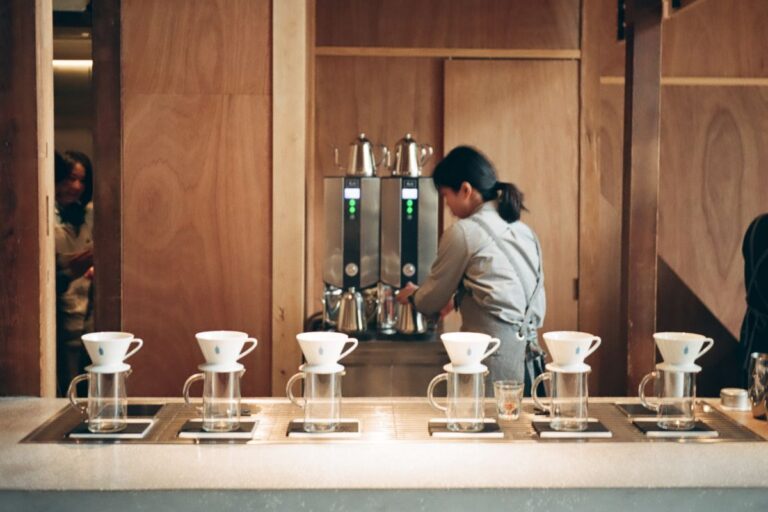You probably associate Japan with tea or maybe even sake.
Who can blame you! Japanese tea ceremonies are genuinely fascinating events.
Coffee in japan has been around for hundreds of years and has evolved into a culture unlike any other.
Here are 12 statistics and facts about Japanese coffee you might not know!
By Kim.
Affiliate disclosure
This page may contain affiliate links – we may earn a small commission when you make a purchase through these links. This is at no extra cost to you.
#1 Coffee Came To Japan From The Dutch
Coffee in Japan originally came from Dutch trading ships in 1600 as they were one of the few countries Japan agreed to trade with.
“It’s Just A Fad.”
“You’ll Get Over It.”
But they did not.
The dutch coffee was initially disliked by the Japanese, thinking it was bitter and unpleasant.
But it persisted; over time, more and more people took a liking to drinking coffee.
I doubt wet beans that have been on a boat for a few weeks would taste very good, so that I can understand their feelings.
It took until the end of the isolation era, 1641 to 1853, to become accepted (maybe they finally got some good quality beans?).
Although Japan banned coffee imports during WWII until 1950, they joined the rest of the world in loving coffee in 1969, when Tadao Ueshima invented the first canned coffee.
#2 Japanese-Grown Coffee Beans
The Japanese have recently started growing their own beans, though only in a small capacity.
Despite not being located in the coffee belt (25 degrees on either side of the equator), Okinawa successfully produces high-quality beans thanks to technology.
#3 So Many Cafes
Japan has more than 174.000 cafes, run by approximately 5000 companies.
Out of these, there are two different types.
What we regularly know as “cafe” and “Kissaten”.
With so many coffee shops in Japan, you’ll always have a new place to discover!
#4 What’s a Kissaten?
Kissaten roughly translates into “Tea-drinking shop”.
These are more traditional-styled coffee shops, forgoing trendy and flashy popularity contests for a more familiar and local experience.
If you want to open your own Kissaten in Japan, you need a Kissaten Business Permit.
This permit differs from a cafe’s restaurant permit because it doesn’t allow you to serve alcohol.
The oldest Kissaten still in business is Cafe Paulista in Ginza and has been around since 1911!
#5 What Are The Most Popular Japanese Coffee Drinks?
The most popular Japanese coffee shop drinks include:
- Iced coffee
- Blended coffee
- Pour-over coffee
Japanese coffee trends tend to focus on quality over quantity, which is why many Japanese coffee shops take their time to perfect each cup of coffee.
There’s nothing like an iced coffee after lunch on a hot summer day!
#6 Does Japan Have Starbucks?
Much like every other country in the world, Japan also has Starbucks.
There are over 1500 stores spread across Japan, making it the 4th largest market in the world for Starbucks.
If you’re visiting Tokyo, why not visit their “Signing Store” and experience their fantastic commitment toward the deaf and hard of hearing.
#7 Cherry Blossom, a.k.a Sakura Latte
Sakura Latte is the pumpkin spice latte of Japan; as soon as spring comes, you’ll find Cherry Blossom-flavored food and drinks everywhere.
Sakura Latte is often made with cherry and strawberry flavor (like this Starbucks version).
If you’d rather have something using actual leaves, Doutor has some superb desserts and drinks.
I’d be lying if I said sakura-flavored anything isn’t one of my guilty pleasures.
You’ll rarely find it outside of Japan; even then, it’s only available for a limited time.
#8 Ueshima Coffee Company Revolutionized Coffee
The most prominent Japanese coffee brand in Japan is Ueshima Coffee Company, which has been around since 1933. In 1969 they introduced the first-ever canned coffee.
Founded by Tadao Ueshima, he has become known as “The father of Coffee in Japan”.
#9 Canned Coffee Reigns Supreme As The Most Popular Coffee In Japan
Thanks to their love of vending machines, canned coffee is Japan’s most popular type of coffee.
During the winter months, the machines will even serve hot cans!
While anything canned doesn’t have the best reputation, believe me when I say some of the best coffee I’ve had came from a vending machine can.

#10 How Many Vending Machines Does Japan Have, You Ask?
5.5 Million.
That’s 1 machine for every 23 people!
With multiple brands of coffee, every device will have something for everyone.
While most machines have a mix of different drinks, some are entirely specialized for coffee.
If you’re lucky, you can find rare drinks, and I’ve made it my mission to drink all of them.
#11 Japanese Coffee Equipment Leads The Way
If you’re looking for the best coffee equipment, you’ll find that most of it come from Japan.
Japanese coffee makers are known for their quality and attention to detail, so you can be sure you’re getting a great product.
Hario and Kalita are two of the more prominent equipment makers founded in Japan. Both have won prizes for their equipment.
#12 What About “Third-Wave” Coffee In Japan?
I’m glad you asked!
Cans are great, but Japan has a quickly increasing number of artisanal baristas and cafes.
Many utilizing equipment traditionally used in the Kissaten of old.
Some will go so far as to mimic the zen experience of tea ceremonies.
Maybe something for the bucket list?
If you’re a coffee lover like me, it’s something you just have to experience.
My favorite shop is Kurasu Kyoto Stand, located near the Kyoto JR train station.
Conclusion
So there you have it, 12 interesting facts about coffee in Japan that you may not have known.
It’s fascinating to see how coffee has become such an integral part of Japanese culture.
There’s something special about how the Japanese have embraced the drink and made it their own.
Every time I’m there, I find new and exciting places for a coffee break.
The next time you find yourself in Japan, try the local coffee shops and varieties.
Thanks for reading!
Photos by seongmi Hond and wipulK007





